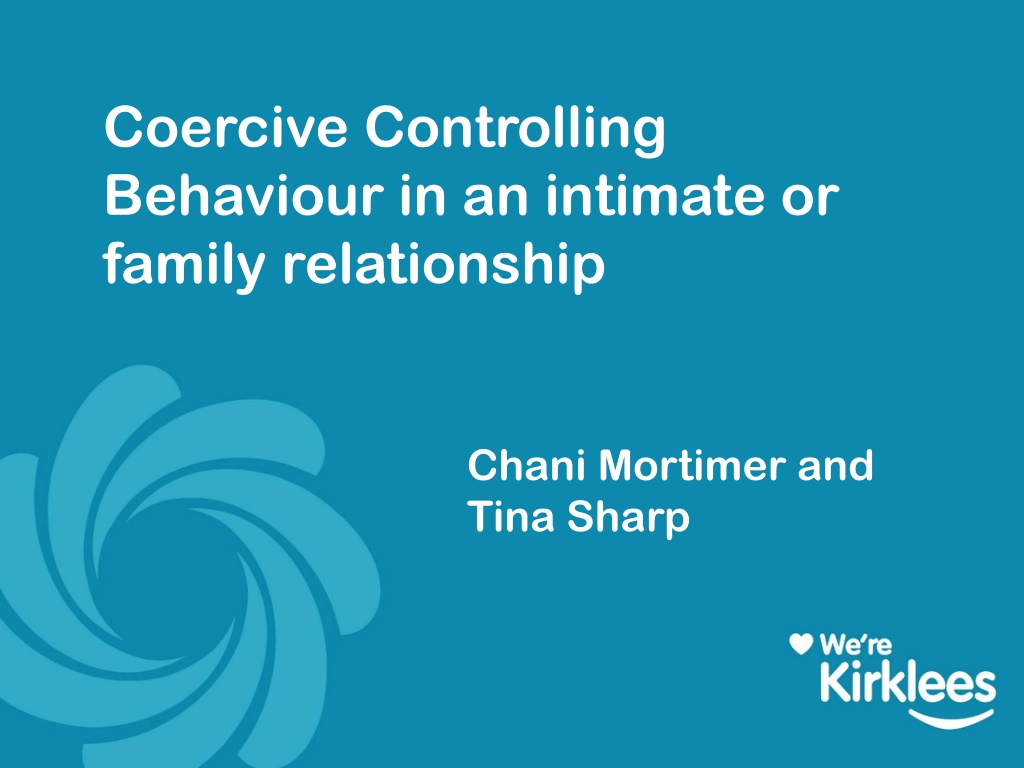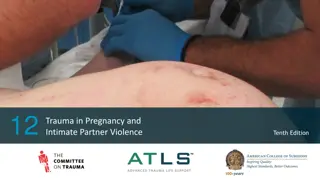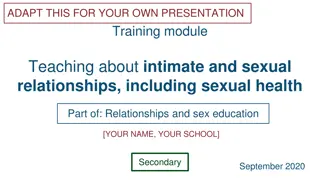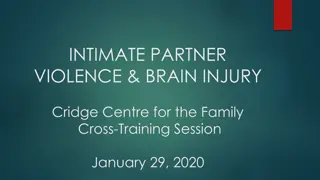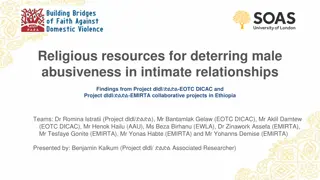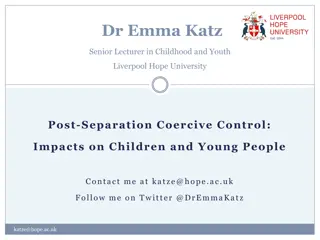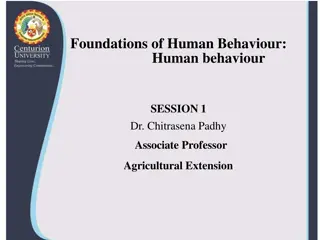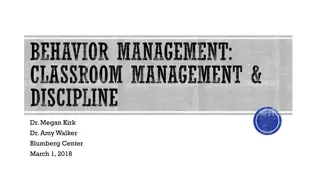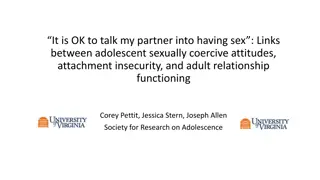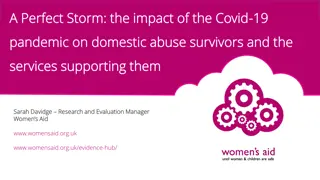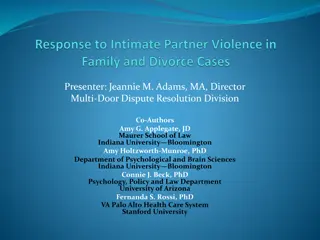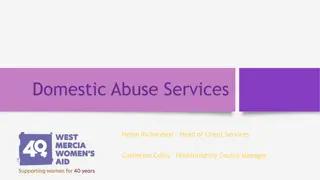Understanding Coercive Controlling Behavior in Intimate Relationships
This course aims to raise awareness of coercive controlling behavior in intimate relationships, covering legislation, impacts on victims, risk assessment, and support measures. Participants are encouraged to reflect on their own relationships and seek support if needed due to the distressing nature of the content.
Download Presentation

Please find below an Image/Link to download the presentation.
The content on the website is provided AS IS for your information and personal use only. It may not be sold, licensed, or shared on other websites without obtaining consent from the author. Download presentation by click this link. If you encounter any issues during the download, it is possible that the publisher has removed the file from their server.
E N D
Presentation Transcript
Coercive Controlling Behaviour in an intimate or family relationship Chani Mortimer and Tina Sharp
Aim: To raise awareness of coercive controlling behaviour Aim: To raise awareness of coercive controlling behaviour legislation and enable participants to respond appropriately to legislation and enable participants to respond appropriately to intimate partner and adult family victims intimate partner and adult family victims Learning outcomes: Explain legislation for coercive controlling behaviour in an intimate or family relationship Describe the impact of coercive controlling behaviour on intimate partner and adult family victims Assess risk from disclosures and victim behaviour Identify measures to assist victims to mitigate risk and for appropriate sources of support
Welcome Welcome This course covers content that some participants may find distressing. Domestic abuse is so prevalent that participants are likely to have some personal knowledge of the impact of domestic abuse on families and individuals they are working with and people they are connected to in their personal lives. Coercive controlling behaviour, like all abusive behaviours, exists as part of a continuum. It is therefore likely that this course will encourage reflection on your own relationships. If there is any content in this course that has caused you some distress, whether due to professional or personal circumstances, please get in touch with your line manager or the organisers of this course to discuss. 3
This course sits within the broader vision in the www.kirklees.gov.uk/beta/domestic-abuse/pdf/domestic-abuse-strategy.pdf
1. What do victims tell us is the worst part of an abusive relationship? 2. Does coercive control include: Limiting access to resources Assault Criminal damage Honour based abuse 3. Is coercive control a new dynamic of abusive relationships? 4. What proportion of domestic homicides include coercive controlling behaviour?
1. Victims tell us controlling coercive behaviour is the worst part of being in abusive relationship CCB includes: limiting access to resources AND assault, criminal damage, honour based abuse Controlling coercive behaviour is not a new dynamic of abusive relationships (but the legislation is relatively new) 92% of domestic homicides include control 2. Answers 3. 4.
Coercive Control Deliberate and calculated pattern of behaviour and psychological abuse designed to isolate, manipulate and terrorise a victim into complete fearful obedience. Uses isolation, gaslighting, micro-managing, surveillance, humiliation and degradation Creates an environment confusion and extreme threat Is incremental and very hard for victims to detect Makes it difficult for victims to trust anyone, make their own decisions, or meet their own needs NOT a reaction to stress, alcohol or drugs You become disoriented, hyper vigilant, confused and most likely sleep-deprived. You are walking on eggshells. Afraid you re going mad. Afraid to make them mad. Sometimes not knowing why you re afraid or what you re afraid of. Afraid. All the time.
Coercivecontrol is an offence if A REPEATEDLY OR CONTINUOUSLY ENGAGES IN BEHAVIOUR TOWARDS ANOTHER PERSON, B, THAT IS CONTROLLING OR COERCIVE; AND AT TIME OF THE BEHAVIOUR, A AND B ARE PERSONALLY CONNECTED; AND THE BEHAVIOUR HAS A SERIOUS EFFECT ON B; AND A KNOWS OR OUGHT TO KNOW THAT THE BEHAVIOUR WILL HAVE A SERIOUS EFFECT ON B.
Claire and Charlotte Hart Control is the point of abuse. Violence is just a way to gain control and our father had managed to gain control without violence. Luke Hart Available from: https://www.youtube.com/watch?v= AYDJ52_l_cg
What are some tactics in coercive controlling behaviour? Take a few minutes to consider: Isolation Economic Tech Gaslighting
Guilt for wanting to spend time with other people you care more about them than you do about me Jealousy, constant contact, being rude to visitors No one understands the victim better or cares more than the perpetrator does, them against the world Victims may feel defensive or misunderstood Perpetrators may move them Isolation Isolation from family and friends seen in 78% DHRs
Economic abuse limits victims choices and ability to access safety. Its not just about money, but access to resources Control how their partner acquires money and economic resources (work, benefits, bank accounts) Limit how their partner uses resources Sabotages partners resources (theft, damage to property, spends all the money, building up debt) https://survivingeconomicabuse.org/ Economic
Monitoring of messages, emails and social media Threatening to share personal or inflammatory information online Using GPS geolocator or software to track the victim s movements Using spyware, keystroke logging hardware, caller ID and spoofing Hidden cameras https://safelives.org.uk/tech-vs-abuse Tech
To manipulate (someone) by psychological means into doubting their own sanity Gaslighting It comes from a 1930s play Gaslight. A husband successfully drives his wife mad by constantly changing the lighting in their house and denying that there was any change. Over time, the wife becomes so doubtful of her own perceptions that she comes to rely on her husband for everything.
Idealisation the gaslighter is the answer to all your problems. Then Victims cannot do anything right Perpetrator rewrites history, makes backhanded compliments, says victims are overly sensitive It s her crazy behaviour that requires him to control her . . . she s the abusive partner. She s so out of touch with reality that she needs help Gaslighting
Why is this so effective? The person who is isolating, controlling, manipulating, abusing and dehumanising you is also the person who is providing you with the basics you need to live, or offer some pain relief, psychological contact or affection
Relationships are hard In many relationships, there are occasions when one person makes a decision on behalf of another, or when one partner takes control of a situation and the other has to compromise. The difference in an abusive relationship is that decisions by a dominant partner can become rules that, when broken, lead to consequences for the victim.
The CCB continuum Cooperative relationships Coercive relationships Coercive entrapment Mutual support Controlling tactics Victim deprived of choices and resources Shared decision making Sacrifices to avoid conflict/ punishment i.e. isolating self Arguments without fear, threats or punishment Trauma bonds Stockholm syndrome Victim may still resist sometimes
Research shows that psychological control tactics are used more commonly and effectively by men against women Many gaslighting tactics are based on traditional gender stereotypes and women s irrationality romantic relationships are where traditional gender ideologies are strongest i.e. men seen as autonomous and in control; women are more dependent and emotional Intersecting inequalities BME, poverty, disability, immigration status, mental ill health, substance misuse increases vulnerability to abuse Is this a gendered issue?
Most identified cases concern people in intimate partner relationships Only between intimate partners? Likely to be significantly under reported in: Adult children against their parents Carer relationships Extended family (including so called honour based abuse)
Exploring the impact of coercive controlling behaviour on victims. Consider: Health Physical, mental, nutrition, exercise, access to appointments Relationships Family, friends, colleagues, acquaintances Productivity Are you doing well in school, work, managing your home? Aspirations What does the future hold? What options do you have?
Why dont they just end the relationship? Many victims don t know they are experiencing abuse until they are in incredibly dangerous situations. By the time victims realise and can acknowledge the danger they re in, many believe no system will ever be powerful enough to keep them safe. So they stay, even after they want to leave, and know it s dangerous. They stay because it may be even more dangerous to leave. If they do report to professionals, they are making a terrifying gamble. Jess Hill, author See What You Made Me Do
When you hear those red flags isolation, micro-management, rule-setting, financial control respond carefully. Listen without judgement Know when you need to report safeguarding concerns and remind victims of your professional responsibilities. Always record your concerns Try to understand the benefits of the relationship (victims will be getting something out of it, so having those needs met elsewhere may give them more agency to leave) Tell them why their perpetrator s behaviour concerns you, but try not to be too critical, which will only make them defensive. Try to keep in contact, if you can. The perpetrator wants them to be isolated don t enable them. Record every contact and every allegation. Empower victims through safety planning www.womensaid.org.uk/the- survivors-handbook/making-a-safety-plan/ How can we support victims?
Professional responsibilities: report crimes to police safeguard vulnerable adults safeguard children Reporting safeguarding concerns Professionals can also: Seek support from PDVG Make a referral to DRAMM-MARAC
Safeguarding means protecting an adult s right to live in safety, free from abuse and neglect Every adult has the right to make his or her own decisions and should be supported to do so Raise concerns without consent when it is in the public interest to do so (safeguard an adult or child, prevention or detection of crime, public protection) The MCA is designed to protect and restore power to those adults at risk who lack capacity Capacity and Consent
Coercive control may cause more harm to children than witnessing physical violence. Research by Emma Katz suggests: Impact on children children experience behavioural and emotional difficulties as a result of coercive control feeling isolated at home because the perpetrator monopolised the victim s time; language and developmental delay due to lack of opportunities for play; and broader isolation as not allowed to spend time with family members, have visitors to the home or attend appointments Children learn to limit what they say and do (to avoid further abuse) Impact on victims can affect their capacity to provide care for children.
Supporting the Police to prosecute perpetrators of coercive controlling behaviour
Coercive Controlling Behaviour legislation Prior to Serious Crime Bill 2015 there was no domestic abuse specific offence Domestic abuse crimes frequently prosecuted as assault, sexual assault, criminal damage, threats to kill, harassment, threatening behaviour Difficult to evidence pattern of behaviour Non violent behaviour with equally devastating impact on victim is Coercive and Controlling Behaviour
CCB (Serious Crime Act 2015) Pattern of behaviour must have had serious effect on victim Fearing violence on at least two occasions , OR caused serious alarm or distress, substantial adverse effect on victim s day-to- day activities Perpetrator and victim have to be personally connected
Substantial adverse effects Stopping or changing the way someone socialises Physical or mental health deterioration A change in routine at home including those associated with mealtimes or household chores Attendance record at school Putting in place measures at home to safeguard themselves or their children Changes to work patterns, employment status or routes to work
CCB (Serious Crime Act 2015) A person guilty of an offence under this section is liable: On conviction on indictment, to imprisonment for a term not exceeding five years, or a fine, or both; On summary conviction, to imprisonment for a term not exceeding 6 months, or a fine, or both.
Evidence Witness testimony Bank statements Diary/harassment logs Victim statements Professional statements GPS tracking devices Copies of emails, texts, phone records, social media Photographs 999 calls, body worn cams, CCTV Records of contact with services Medical records
Graham OShea 1st person in West Yorkshire to be convicted in 2016 4 years imprisonment and lifelong restraining order Six week relationship he wasn t letting her wash; she smelled, she was dirty and dishevelled; he would make her have sex with every night; he had her bank card, he wouldn t put any gas or electric on the meter www.examinerlive.co.uk/news/west-yorkshire-news/halifax-man-jailed- coercive-control-12126989
While we can do a lot to support victims, change is hard to achieve There was significant evidence, despite the mother s assertions that the relationship had ended, that the father remained in contact with her and the children. The daily difficulties that the mother faced as an abused and coerced woman and the impact that this would have on her decision making, her self-identity and her ability to protect herself and the children was not understood. Analysis from a serious case review
Supporting victims of controlling behaviour Available from: https://www.youtube.com/watch?v=36mQFefBylM
Local services Pennine Domestic Abuse Partnership (PDAP) A key provider of domestic abuse support services in Kirklees. We believe that everyone has the right to live free from all forms of abuse and have the right to be free from potential or actual harm. 24 hour helpline O800 052 7222 https://pdap.co.uk/ Kirklees DRAMM-MARAC Team Coordinates the multi-agency risk assessment and safety planning processes for high risk cases of domestic abuse. 07977 986744 or 01924 482112
Safeguarding Adults Everyone has the right to live in safety, free from abuse and neglect. If you are concerned that an adult at risk living in Kirklees is being abused you can telephone, visit or email us using the contact details below:- Report abuse or seek advice contacts Kirklees Council Customer Service Centre Civic Centre 3, Market Street, Huddersfield, HD1 2TG Gateway to care Walsh Building, Town Hall Way, Dewsbury, WF12 8EQ Phone 01484 414933 Open 24 hours a day Email secure.gatewaytocare@kirklees.gcsx.gov.uk
What to do if you are worried about a child Professional responsibility for safeguarding Children s Social Care Service 01484 456848 Kirklees Emergency Duty Service 01484 414933 (out of office hours) NSPCC Helpline: 0808 800 5000 NSPCC email: help@nspcc.org.uk NSPCC text: 88858 (free service)
Reporting to Police Professionals have a duty to report safeguarding concerns to police Emergency 999 Crimes reported to 101 Police Information/Advice Safeguarding Unit 01924 335073
